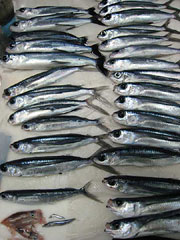

 | |||||||
|
|
Journals 2007/2008Heather Judkins
November 17, 2007 One of the projects conducted each night is dipnetting off the side of the ship with the intent to catch the various flyingfish species that are swimming by. Dipnetting occurs simultaneously while the night CTD is being dropped to 1000 m as the ship stays in one position. My idea of dipnets were the small ones I use with my classes, about 2 feet long with a net on one end. Well, the dip nets that are used for the project are about 20 feet long and have a huge net on one end! Needless to say, it's a bit tricky to be successful.  Flying fish are found in large schools in the ETP, and are often seen gliding over the water around the ship. They are estimated to glide for 20 meters or more. I have been practicing my dipnetting skills and it is not especially pretty, but I have gotten better at the art! I have caught fish and a few squid in my attempts. Sometimes as the fish get spooked, they will actually hit the side of the ship which translates into an easy catch! The flying fish are studied for their stomach contents. There are 4 species of flyingfish that are caught and then brought into the wet lab to be processed. Each fish is numbered and identified before the stomachs are removed. The scientist will cut open the fish from the anus to the gills, snip the top of the stomach near the heart and at the base near the anus before removing the guts. It is then put in a small sample bag with formalin for analysis back on land. Why is this important? Little is known about their eating habits in the region and they are an important link in the food webs in the ETP.  There are other interesting things that are caught in the dip nets as well. We have caught many squid (some are kept, most released), flotsam with small invertebrates on them, a couple of pelagic pufferfish, and during the last leg, they caught a small juvenile Olive Ridley turtle! On another note, animals I missed today- jumping shark, a beaked whale, and a marlin. The one I did see? Another BLUE WHALE! So cool! Marine Science Questions: 1. What is the difference between flotsam and jetsom? 2. What do you think the flyingfish eat in the ETP? (list at least 3 organisms) |
||||||